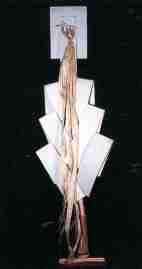[Contents] [Back] [Next] [Section VI: Props]
Props It is often said that there is no such thing as Kagura performed without props. Kagura is an art form created over many generations by our ancestors, and its ties to nature are strong. When you recognize this connection, the symbolism in each prop becomes apparent. At the beginning of a Kagura performance, the person performing the ceremonial dance holds a gohei (purification wand). He looks just like a farmer reaping his rice. His task is difficult but his reward is great. The rice is a gift from the gods. The gohei is a symbol for one who lives in harmony with the great outdoors. The fan used by the maiden in Momiji-gari reminds one of flowers dancing in the wind. In the story of the Eight-tailed Serpent, it is said that the serpent's eating of the seven daughters one after represents a field being consumed by a flood. When the seventh princess is eaten, her silk cloth remains in the serpent's mouth, reminding us of her dance earlier in the performance and doubling our fear of nature. The climax of most performances is the fight between the demons and the gods. Props for these scenes include spears, swords, and bows. As these are used to drive away dangerous beasts and birds, they are an important part of the performance. |
|
NPO Hiroshima kagura Art Laboratory |
